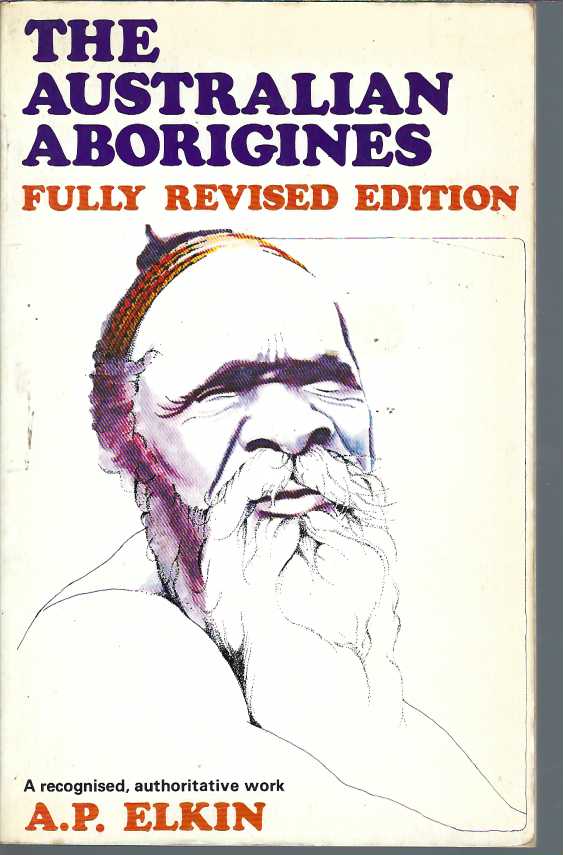First published in 1938; this edition is a revised version of The Australian Aborigines; how to understand them 4th ed; New preface discusses the history of the book; Antiquity, origin and migrations, language information; Living off the land, seasons, hunting, artefacts, psychological adaptation, shelters, nomadism; Position amongst the peoples of the world; Tribes and inter-tribal gatherings, customs, local groups, family, kinship, classificatory system, types of systems (Ngarinjen, Nyul Nyul, Aranda, Luritcha, Karadjeri, Kariera); Social groups, section and moieties, alternative and irregular marriages; Kinship avoidance, taboos, methods of obtaining a wife, marriage of old men and young girls, pirauru relationship; Totemism; Secret life and initiation, missionary problems; Meaning and social function of rites; Philosophy and beliefs, increase rites, mythology and mythological figures – sky heroes, mother-goddess cult, rainbow serpent; Art and rituals – 8 art regions, bark paintings, carving; Music and dancing, sacred chanting, musical instruments, secular music, musical patterns, Songman, description of dances, diffusion, poetry, song and chant and cycles; Medicine men and magic, causes of illness and death, making of medicine men; Death, inquest and revenge, burial rites, fate after death; Briefly summarizes the phases of Aboriginal European contact and past govt. policies, growing Aboriginal involvement and the development of Aboriginal service and welfare organizations; Mixed-bloods, disintegration of traditional life, and the problems of prejudice; Aboriginality and cultural identity.
xv, 397 p., [16] p. of plates : ill. ; 22 cm. Bibliography: p. [389]-390. #260622
Australian Aborigines. Cultural processes | Aboriginal Australians. | Karajarri people (A64) (WA SE51-10) | Stories and motifs – Rainbow serpent. | Social organisation – Kinship – Marriage – Wrong marriage. | Social organisation – Avoidance rules – Avoidance relationships. | Death – Mortuary / funeral ceremonies. | Music – Instruments. | Luritja / Loritja people (C7.1) (NT SG52-04) | Music – Musicians – Composers and songwriters. | Language – Linguistics – Language classification. | Kariyarra language (W39) (WA SF50-10) | Health – Treatments – Traditional – Clever people. | Death – Inquests. | Technology. | Religion – Rites – Increase. | Social organisation – Avoidance rules – Language. | Family. | Ngarinyin / Ungarinyin people (K18) (WA SE52-01) | Stories and motifs – Creation / Cosmology. | Social identity – Aboriginality. | Religion – After death beliefs. | Karajarri language (A64) (WA SE51-10) | Government policy – Assimilation. | Habitation – Nomadism. | Ngarinyin / Ungarinyin language (K18) (WA SE 52-01) | Ceremonies – Initiation. | Aged. | Nyulnyul / Nyul Nyul people (K13) (WA SE51-02) | Feuds and warfare – Avenging. | Kariyarra people (W39) (WA SF50-10) | Music – Vocal. | Arrernte / Aranda language (C8) (NT SG53-02) | Stories and motifs – Cultural heroes. | Race relations – Racial discrimination. | Environment – Climate and weather – Seasons. | Luritja / Loritja language (C7.1) (NT SG52-04) | Social organisation – Kinship – Marriage. | Art – Painting – Bark. | Religion – Totemism. | Performing arts. | Nyulnyul / Nyul Nyul language (K13) (WA SE 51-02) | Arrernte / Aranda people (C8) (NT SG53-02) | Social organisation – Kinship – Systems – Moieties. | Australia.
Australian Aborigines, The (Fully Revised Edition)
$25.00
Sold Out
Additional Information
| Author | Elkin, A. P. (Adolphus Peter), 1891-1979 |
|---|---|
| Number of pages | xv, 397 p., [16] p. of plates : ill. ; 22 cm. |
| Publisher | Angus & Robertson |
| Year Published | 1976 reprint |
| Binding Type | Softcover |
|---|---|
| Book Condition | Very Good + |
